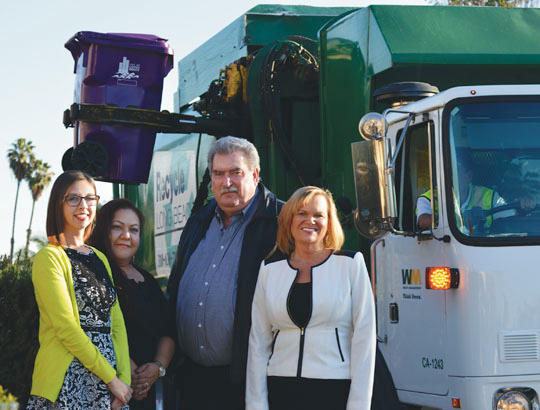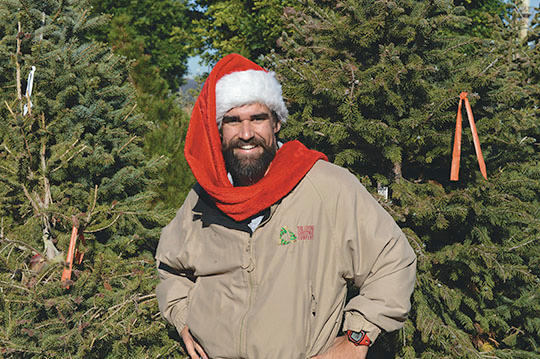The holiday season often brings cheer and togetherness, but it also generates a lot of waste.
On a national scale, Americans produce about 1 million more tons of waste, about a 25 percent increase, between Thanksgiving and New Year’s Day, according to the United States Environmental Protection Agency (EPA).
In Long Beach, the city handles about 200 to 250 extra trash truck loads in December alone, a nearly 15 percent increase, and collects about 250 tons of Christmas trees each year to be recycled, said Jim Kuhl, director of the Long Beach Environmental Services Bureau.
“If there’s anything residents and businesses can do to reduce their [waste] footprint, the earth would appreciate that,” he said.
Since the recession, people have continued to take steps to reduce consumption during the holidays as a way to save money, said Janine Hamner, manager of municipal and community relations for Texas-based Waste Management, Inc., which provides recycling services for the City of Long Beach.

Pictured from left are: Long Beach Environmental Services Bureau Recycling Specialist Leigh Behrens; Long Beach Environmental Services Bureau Recycling Specialist Elisa Calderon, Long Beach Environmental Services Bureau Director Jim Kuhl; and Janine Hamner, manager of municipal and community relations for Waste Management, Inc. (Photograph by the Business Journal’s Larry Duncan)
“The overall volume of materials is down, and it’s down pretty significantly,” she said. “Part of what that says is people just aren’t buying as much . . . More and more people are really thinking about reducing their overall consumption and reusing what they can, and then, with those things that they have, recycling as much as they can.”
While recycling is embraced more these days, people in recent years have started to pay less attention to what belongs in the recycling bin versus the trash can, partly because recycling has become more difficult for people with busier lifestyles, Hamner said.
“For the first time in probably 40 years, we have seen an uptick in the amount of stuff that is recyclable ending up in the trash,” she said. “Part of it is that people in our modern-day society have become more and more busy, our lives have become more and more hectic, and recycling has become more and more complicated, honestly.”
During the holidays, residents and businesses are encouraged to follow an old but simple rule: reduce, reuse and recycle. The phrase, known as the “Three Rs,” is in hierarchical order of waste-diversion effectiveness, Hamner explained.
“We are starting to do a lot of work with our communities, reeducating people and taking it back to the basics,” she said. “We would encourage you to go back to school and remember those three Rs.”
One way to reduce waste, Hamner said, is to buy gifts or holiday decorations with less packaging.
“If you’re looking for holiday gifts or looking for things for your home or holiday decorations, a great way to sort among potential things to buy is to look at the kind and volume of packaging that things come in,” she said. “If you’re ordering stuff online, check that box that says, ‘bundle packages together,’ because then things will come in one box as opposed to multiple boxes.”
People can also cut down on waste by saving wrapping paper, gift bags, packages and decorations to reuse them for multiple holidays or another occasion as opposed to buying new each year, which ultimately saves money, Hamner said.
“Rather than ripping your holiday paper to shreds in the excitement of holiday morning unwrapping, you could do it a little more carefully and save some of that wrapping paper to use it again next year,” she said.
Another solution for making the holidays more sustainable is to rent a living Christmas tree rather than buying a cut one, which has to be hauled in from other states only to be turned into mulch.

Scott Martin, better known as “Scotty Claus,” founded The Living Christmas Co., which is based in Re- dondo Beach, in 2008 as an operation that rents out living Christmas trees as an ecological alternative to cut or artificial trees. After the potted trees are used for Christmas, they are brought back to a nursery, where they continue to grow. Once the trees have lived out there use, they are donated to local urban forestation projects. (Photograph by the Business Journal’s Larry Duncan)
One local operation that rents out living Christmas trees is The Living Christmas Co., based in Redondo Beach. Founded in 2008 by Scott Martin, better known as “Scotty Claus,” the company rents out live Christmas trees and then brings them back to a nursery, where they continue to grow, repurposing local industrial land. Once the trees have outlived their use as Christmas trees (reaching about 15 feet), they’re donated to local urban forestation projects.
Martin, who has seen his business grow since appearing on the TV show Shark Tank in which he received a $150,000 investment from businessman and Dallas Mavericks owner Mark Cuban, said renting living Christmas trees is more sustainable for the environment and a better use of resources than buying cut trees that are trucked in mostly from Oregon and Washington.
“You’re transporting resources from one part of the country to another,” Martin said. “From an ecological standpoint, being able to grow trees locally and plant them so they can grow is a better use of resources.”
He said living Christmas trees are also an ecological alternative to artificial trees, which are often made out of petroleum-based, non-recyclable material that become a liability for future generations.
Martin added that his company, which hires local veterans and low-income residents to transport trees during the holidays, also offers its own line of eco-friendly ornaments and recycled wrapping paper, available for purchase online at www.livingchristmas.com.
“We want to redefine what it really means to have a living Christmas,” he said. “Everything has a storyline and a lifeline.”
For residents who choose to buy regular cut Christmas trees this season, however, the City of Long Beach is scheduled to pick up trees left out near trash cans on Saturday, January 9, and offers free drop-off locations throughout the city from December 26 to January 8.
As for recycling other materials, Hamner said people should be aware that recyclables are typically bottles, cans, plastic and paper, including cardboard boxes. However, materials that become soiled with food, such as oily pizza boxes, can’t be recycled and belong in the trash.
“It’s all about the state of affairs,” she said. “The rule of thumb we always talk about is, if it’s ooey, gooey or chewy, then it does not belong in the recycling.”
E-waste is also a major contributor to the holiday waste stream as people take advantage of holiday savings to upgrade electronic devices, said Elisa Calderon, recycling specialist for the Long Beach Environmental Services Bureau. She notes that it is illegal to throw away electronics in the trash since they are considered hazardous waste and must be disposed of properly.
Calderon said more than 75 tons of e-waste was dropped off at the EDCO Household Hazardous Waste (HHW) collection center in Signal Hill last year while an additional 63 tons of e-waste was collected throughout Long Beach either as dumped items or through service requests.
